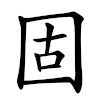固
See also: 周
| ||||||||
Translingual
| Stroke order | |||
|---|---|---|---|

| |||
Han character
固 (Kangxi radical 31, 囗+5, 8 strokes, cangjie input 田十口 (WJR), four-corner 60604, composition ⿴囗古)
Derived characters
References
- Kangxi Dictionary: page 218, character 3
- Dai Kanwa Jiten: character 4745
- Dae Jaweon: page 445, character 23
- Hanyu Da Zidian (first edition): volume 1, page 716, character 9
- Unihan data for U+56FA
Chinese
| simp. and trad. |
固 | |
|---|---|---|
Glyph origin
| Historical forms of the character 固 | |||
|---|---|---|---|
| Western Zhou | Warring States | Shuowen Jiezi (compiled in Han) | Liushutong (compiled in Ming) |
| Bronze inscriptions | Chu slip and silk script | Small seal script | Transcribed ancient scripts |

|

|

|

|
| Old Chinese | |
|---|---|
| 箇 | *kaːls |
| 個 | *kaːls |
| 居 | *kɯ, *kas |
| 橭 | *kaː, *kʰaː |
| 嫴 | *kaː |
| 姑 | *kaː |
| 辜 | *kaː |
| 酤 | *kaː, *kaːs, *ɡaːʔ |
| 蛄 | *kaː |
| 鴣 | *kaː |
| 沽 | *kaː, *kaːʔ, *kaːs |
| 盬 | *kaː, *kaːʔ |
| 古 | *kaːʔ |
| 罟 | *kaːʔ |
| 估 | *kaːʔ |
| 鈷 | *kaːʔ |
| 詁 | *kaːʔ |
| 牯 | *kaːʔ |
| 故 | *kaːs |
| 固 | *kaːs |
| 稒 | *kaːɡs |
| 痼 | *kaːɡs |
| 錮 | *kaːɡs |
| 鯝 | *kaːɡs |
| 棝 | *kaːɡs |
| 凅 | *kaːɡs |
| 枯 | *kʰaː |
| 軲 | *kʰaː |
| 跍 | *kʰaː |
| 骷 | *kʰaː |
| 苦 | *kʰaːʔ, *kʰaːs |
| 葫 | *qʰaː, *ɡaː |
| 餬 | *ɡaː |
| 瑚 | *ɡaː |
| 湖 | *ɡaː |
| 鶘 | *ɡaː |
| 猢 | *ɡaː |
| 醐 | *ɡaː |
| 糊 | *ɡaː |
| 箶 | *ɡaː |
| 蝴 | *ɡaː |
| 胡 | *ɡaː |
| 瓳 | *ɡaː |
| 怙 | *ɡaːʔ |
| 祜 | *ɡaːʔ |
| 岵 | *ɡaːʔ |
| 婟 | *ɡaːʔ, *ɡaːɡs |
| 楛 | *ɡaːʔ |
| 据 | *ka |
| 裾 | *ka |
| 琚 | *ka |
| 椐 | *ka, *kas, *kʰa |
| 鶋 | *ka |
| 蜛 | *ka |
| 崌 | *ka |
| 涺 | *ka |
| 腒 | *ka, *ɡa |
| 鋸 | *kas |
| 倨 | *kas |
| 踞 | *kas |
| 涸 | *ɡaːɡ |
Phono-semantic compound (形聲/形声, OC *kaːs) : semantic 囗 + phonetic 古 (OC *kaːʔ).
Etymology
STEDT compares it to Proto-Sino-Tibetan *r-ka (“earth; ground; soil”).
Pronunciation
Definitions
Compounds
Lua error in Module:zh/templates at line 32: This template has been deprecated. Please use Template:col3 instead.
Descendants
Japanese
Kanji
固
- This term needs a translation to English. Please help out and add a translation, then remove the text
{{rfdef}}.
Readings
- Go-on: く (ku)
- Kan-on: こ (ko, Jōyō)
- Kun: かためる (katameru, 固める, Jōyō); かため (katame); かたまる (katamaru, 固まる, Jōyō); かたい (katai, 固い, Jōyō)
Compounds
- 固形 (kokei)
- 固執 (koshitsu), 固執 (koshū)
- 固守 (koshu)
- 固相 (kosō, “solid phase”)
- 固体 (kotai)
- 固定 (kotei)
- 固有 (koyū)
Korean
Hanja
固 • (go) (hangeul 고, revised go, McCune–Reischauer ko)
- This term needs a translation to English. Please help out and add a translation, then remove the text
{{rfdef}}.
Vietnamese
Han character
(deprecated template usage) 固 (cố, có, cuá)
- This term needs a translation to English. Please help out and add a translation, then remove the text
{{rfdef}}.
Categories:
- CJK Unified Ideographs block
- Han script characters
- Translingual lemmas
- Translingual symbols
- Han phono-semantic compounds
- Chinese terms inherited from Proto-Sino-Tibetan
- Chinese terms derived from Proto-Sino-Tibetan
- Middle Chinese lemmas
- Old Chinese lemmas
- Chinese lemmas
- Mandarin lemmas
- Cantonese lemmas
- Hakka lemmas
- Hokkien lemmas
- Teochew lemmas
- Chinese adjectives
- Mandarin adjectives
- Cantonese adjectives
- Hakka adjectives
- Hokkien adjectives
- Teochew adjectives
- Chinese verbs
- Mandarin verbs
- Cantonese verbs
- Hakka verbs
- Hokkien verbs
- Teochew verbs
- Chinese nouns
- Mandarin nouns
- Cantonese nouns
- Hakka nouns
- Hokkien nouns
- Teochew nouns
- Chinese adverbs
- Mandarin adverbs
- Cantonese adverbs
- Hakka adverbs
- Hokkien adverbs
- Teochew adverbs
- Chinese terms with IPA pronunciation
- Chinese Han characters
- Japanese Han characters
- Grade 4 kanji
- Japanese kanji with goon reading く
- Japanese kanji with kan'on reading こ
- Japanese kanji with kun reading かた-める
- Japanese kanji with kun reading かため
- Japanese kanji with kun reading かた-まる
- Japanese kanji with kun reading かた-い
- Korean lemmas
- Korean Han characters
- Vietnamese lemmas
- Vietnamese Han characters